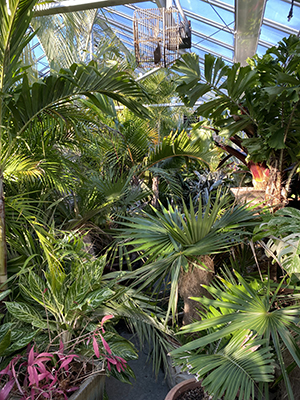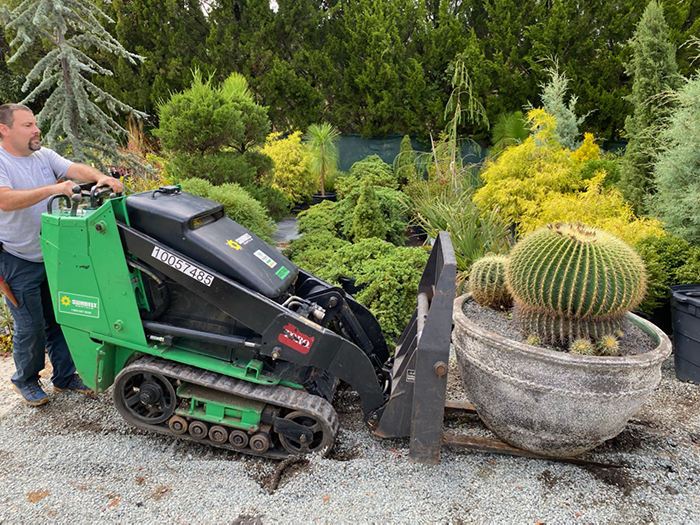Garden Talk
Survive vs. Thrive
By April Stradley
Historic Gardens Horticulturist

Depending on where you live within our area, you might have noticed a sharp dip in nighttime temperatures in mid-October. Maybe you even had a freeze warning ding on your phone. Did you run outside to drape a burlap cloth over your sago palm or prized mangave? Did you shrug it off?
Here at Duke Gardens, we responded with a sense of urgency. We have hundreds of non-hardy plants — plants intolerant to cold temperatures — around the garden that must be stored in the greenhouse during the winter months: tropical palms, cacti, African milk trees, bananas, bromeliads, air plants, etc. We only had a few days’ notice of the change in weather, so we had to get busy! There were teams bringing in plants from the landscape, including 10-foot tall foxtail palms (Wodyetia bifurcata) and golden barrel cactus (Echinocactus grusonii) in pots that weighed more than 500 pounds; teams transferring plants from ornamental ceramic pots into plastic nursery pots; and teams performing organizational miracles in order to fit everything in the greenhouse. It was a great feat of skill and logistics that we were all relieved to complete.
Then I came home the evening before the freeze with the same daunting task still ahead of me. Luckily, I only had 16 non-hardy plants that had to become “inside pets” before bedtime.
First, I inspected the soil and foliage for undesirable insects and pathogens, dead leaves, and debris, and then my partner and I carried the plants up to my second-floor apartment. My partner did most of the carrying, especially when it came to my 4-foot umbrella plant (Schefflera arboricola) and my 6-foot corn plant (Dracaena fragrans). Next, we had to rearrange furniture to accommodate them—always a joy. Finally, we crowded the remaining plants into their winter homes near windows, somewhat according to the plants’ various needs, but mostly based on my needs. (Sorry plants, but I need navigable paths; I need floor space for my yoga mat.) As the task wore on, my need for dinner and pajamas became all-consuming. I’m sure my neighbor heard me finally declare, “Whatever, they’ll live!”
Now my apartment is a jungle, and not in a cute way. Did you bring inside several prized non-hardy plants that are now living rent free in your home? Perhaps your houseplant hobby has overgrown your time and attention thresholds? Maybe at one point, when they were all young and cute, there was plenty of window space in the winters for the houseplants, but now they’re monstrous and multiplying! If such is the case, let me reiterate one thing in the form of advice: they will live. My singular goal this winter is plant survival. Frankly, I will be in a pickle if any of them grows even a little bit. Here’s the truth you might not find in any trending indoor plant blog: your plants do not always need to thrive.
I know, this advice sounds harsh, and it might grate against your nurturing instincts. But plants are not physiologically inclined to thrive all year round, year after year. Plants, like people, have phases of vigorous and slower growth. Over the winter months, when the sun is coming through your windows at a low angle and for a short duration, and your house is so dry and warm that you get shocked by everything you touch, it is completely OK and normal for your plants to just sit there and survive. They might even start to drop leaves, and that’s totally fine. Cut back those old, yellowing leaves, water sparingly, and let your plants slow down. Maybe you do, too. Make a cup of tea and re-watch "Buffy" for the dozenth time.
In other words, I encourage you to have faith in your plants’ resilience. Even if you tried, you might not be able to kill them before March. Spring will come, and when it does you can wake up your plant babies, repot them, give them a snack and put them back in their sunny spot on the porch. We will be doing the same here at the Gardens!
#indoorjungle #survivenotthrive #selfcare #buffy #interiorplantscapes #wintergardening
Photos from top: Curator Jason Holmes uses machinery to lift a large potted golden barrel cactus in the Historic Gardens; lush foliage of potted palms and other tender tropical plants in the Duke Gardens greenhouse. Both photos by April Stradley.






